Request Follow-up Letters Made Simple: Unlock Success with 25 Ready-to-Use Templates
Welcome to our website dedicated to “Request Follow-up Letters”! Here, you will find a comprehensive collection of resources, templates, and tips to help you navigate the art of crafting impactful follow-up letters. Whether you’re seeking to express gratitude, inquire about the status of an application, or maintain professional relationships, our goal is to provide you with the tools and knowledge to create compelling follow-up letters. Explore our wide range of templates, learn best practices for writing, and discover strategies for personalization. We are excited to be your guide on this journey to enhancing your communication skills and achieving successful outcomes through well-crafted follow-up letters.
Tips for Writing Effective Follow-Up Letters
- Structure and Format: Start with a professional and concise introduction that reminds the recipient of the previous interaction or request. Use paragraphs to organize your thoughts and make the letter easy to read. End with a clear and polite closing.
- Tone: Maintain a positive and professional tone throughout the letter. Be polite, respectful, and appreciative. Avoid using overly casual language or sounding demanding.
- Content: Clearly state the purpose of your follow-up letter, whether it’s to inquire about the status of a request, provide additional information, or express gratitude. Keep the content focused and relevant. Be specific about what you are requesting or discussing.
- Personalization: Personalize the letter by addressing the recipient by name and referring to previous conversations or interactions. This shows that you value the relationship and have paid attention to the details.
- Conciseness: Keep the letter concise and to the point. Avoid lengthy explanations or unnecessary details. Use bullet points or numbered lists when appropriate to highlight key information.
- Professionalism: Use proper grammar, spelling, and punctuation. Proofread the letter for any errors before sending it. Maintain a professional and polished appearance to convey your competence and attention to detail.
- Follow-Up Action: Clearly state what action you are expecting from the recipient or what action you will take next. This helps set clear expectations and facilitates a prompt response or follow-up.
- Thank You: Express gratitude or appreciation for the recipient’s time, consideration, or assistance. This shows your professionalism and leaves a positive impression.
- Polite Persistence: If you are following up multiple times, be persistent but polite. Avoid sounding pushy or impatient. Give the recipient enough time to respond before sending follow-up letters.
- Proof of Attachments: If you are attaching any documents or additional information, mention them in the letter and provide a clear explanation of their relevance.
Personalization Techniques
Personalizing follow-up letters is a powerful way to make them more impactful and engaging for the recipients. One effective technique is to reference specific details from previous interactions. This shows that you have been attentive and invested in the relationship, making the recipient feel valued and acknowledged. For example, you can mention a specific topic discussed during a meeting or highlight a shared experience or interest that you both have. By doing so, you establish a connection and demonstrate your genuine interest in the recipient.
When personalizing follow-up letters, it’s essential to strike a balance between being genuine and professional. Avoid being overly familiar or intrusive, and ensure that your personalization efforts are relevant and appropriate. Remember to tailor your language and tone to the recipient’s preferences and the nature of your relationship. By taking the time to personalize your follow-up letters, you demonstrate a higher level of engagement and increase the chances of building stronger connections and achieving your desired outcomes.
#1: Job Interview Follow-Up Letter:
Express gratitude for the interview opportunity, reiterate your interest in the position, and highlight relevant skills and qualifications. A Job Interview Follow-Up Letter serves as a professional and courteous means of expressing gratitude to the interviewer for providing the opportunity to interview for a specific position. This letter aims to leave a positive impression and reiterate the candidate’s interest in the job. It allows the candidate to further emphasize their relevant skills and qualifications, reinforcing their suitability for the role. Ultimately, this letter aims to maintain open lines of communication with the hiring manager, leaving a lasting impression and potentially influencing the final hiring decision.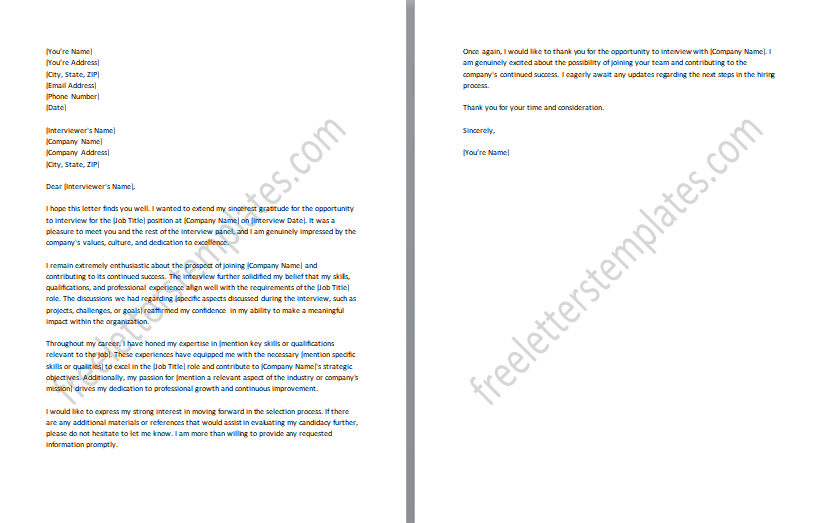
#2: Thank You for the Job Offer Follow-Up Letter:
Show appreciation for the job offer, express excitement, and confirm acceptance or request additional details. A Thank You for the Job Offer Follow-Up Letter is a formal expression of gratitude to the employer for extending a job offer. This letter allows the candidate to convey their genuine appreciation for the offer and express excitement about the opportunity to join the company. Additionally, the letter serves as a confirmation of acceptance, expressing the candidate’s commitment to the position. The purpose of this letter is to maintain a positive and professional relationship with the employer while solidifying the candidate’s acceptance of the job offer.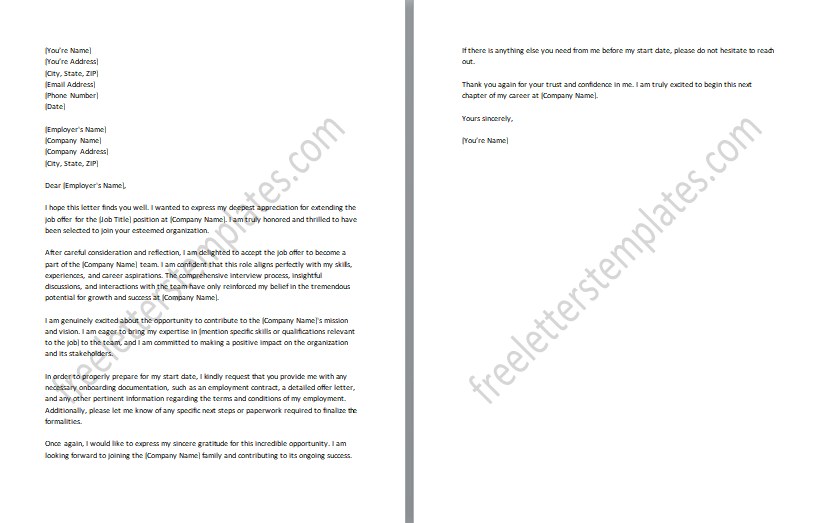
#3: Networking Event Follow-Up Letter:
Send a thank you note to individuals you connected with, express interest in further conversation, and suggest next steps. A Networking Event Follow-Up Letter is a way to extend gratitude and maintain connections with individuals you met at a networking event. This letter allows you to express your appreciation for their time and the opportunity to connect. It also provides an opportunity to express your interest in continuing the conversation and building a professional relationship. You can suggest the next steps, such as scheduling a meeting or phone call to further discuss shared interests or potential collaborations. The purpose of this letter is to strengthen the connection made at the networking event, foster professional relationships, and explore future opportunities for collaboration or mutual support.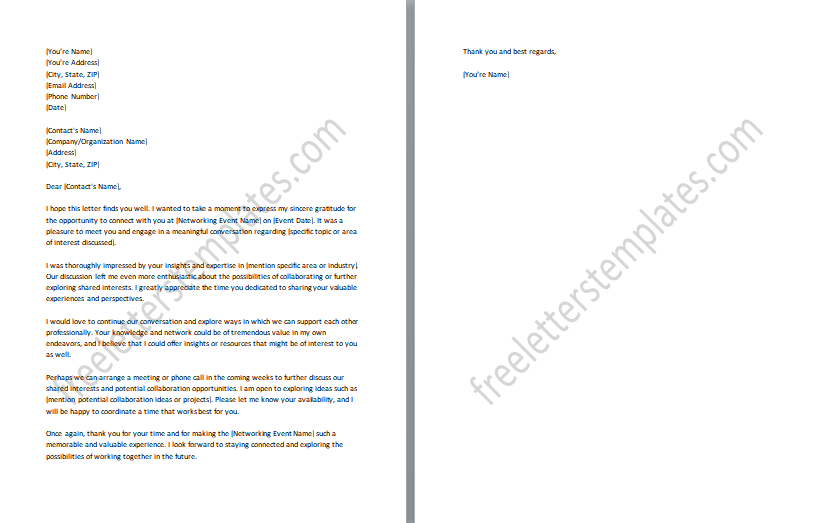
#4: Sales Meeting Follow-Up Letter:
Thank the prospect for their time, summarize key discussion points, and propose the next actions or offer additional information. A Sales Meeting Follow-Up Letter is a way to maintain engagement and continue the conversation with a prospect after a sales meeting. This letter allows you to express gratitude for your time and the opportunity to present your product or service. It is an opportunity to recap the key discussion points from the meeting, highlighting the benefits and value propositions that were discussed. The purpose of this letter is to nurture the relationship with the prospect, keep the sales process moving forward, and address any further inquiries or concerns they may have.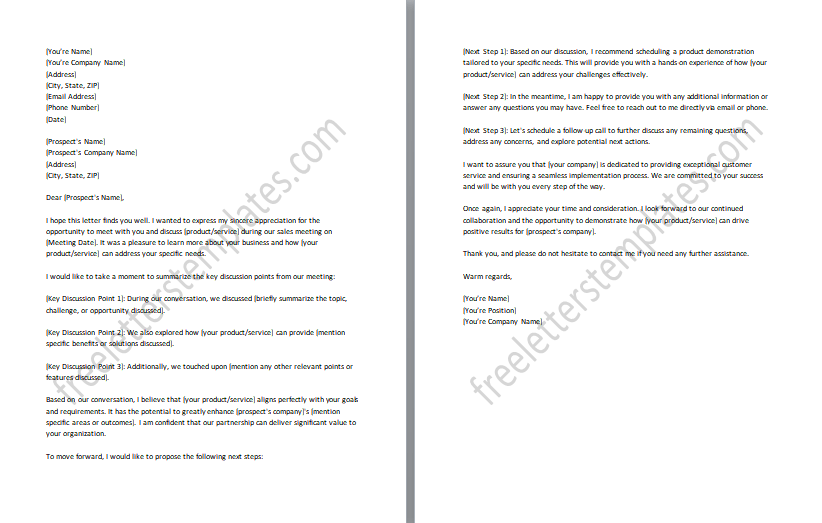
#5: Conference Follow-Up Letter:
Thank conference organizers for the event, mention key takeaways or highlights, and express interest in future events or collaboration. A Conference Follow-Up Letter serves as a way to express appreciation to the conference organizers for hosting a successful event. Additionally, you can mention the key takeaways or highlights from the conference, highlighting specific sessions, speakers, or networking opportunities that were particularly valuable to you. It is also an opportunity to express your interest in future events or collaborations, demonstrating your commitment to continued engagement within the industry or community. The purpose of this letter is to maintain a positive relationship with the conference organizers, express gratitude, and indicate your willingness to participate in future events or explore collaboration opportunities.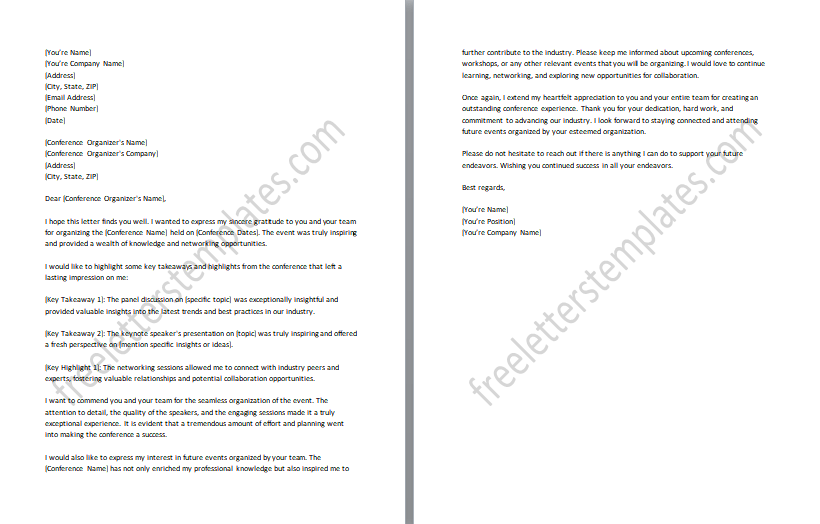
#6: Client Follow-Up Letter:
Extend appreciation to the client for their business, offer assistance with any concerns or questions, and express interest in future projects. A Client Follow-Up Letter allows you to express gratitude to a client for their business and continued partnership. In this letter, you can extend your appreciation for their trust and support, acknowledging the value they bring to your organization. You can also offer your assistance with any concerns or questions they may have, emphasizing your commitment to their satisfaction. Furthermore, it is an opportunity to express your interest in future projects, highlighting your eagerness to continue working together and explore new opportunities. The purpose of this letter is to strengthen the client relationship, ensure their ongoing satisfaction, and foster a long-term partnership based on mutual trust and collaboration.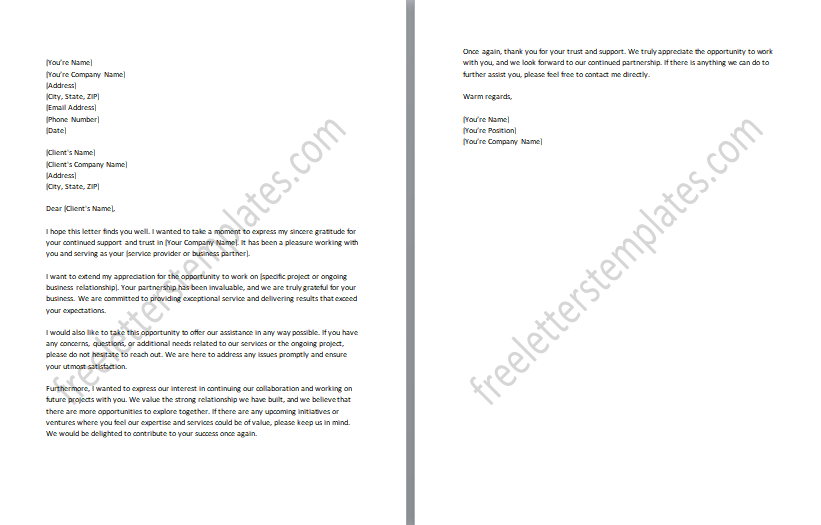
#7: Business Proposal Follow-Up Letter:
Acknowledge the recipient’s receipt of the proposal, restate its key points, and request a follow-up meeting or discussion. A Business Proposal Follow-Up Letter is a professional communication that acknowledges the recipient’s receipt of the proposal. In this letter, you can express appreciation for their time in reviewing the proposal and restate the key points and benefits outlined in the proposal. Additionally, you can highlight the value and potential impact of the proposed solution or partnership. The purpose of this letter is to maintain open lines of communication, demonstrate your commitment to the proposal, and encourage further discussion to move the business opportunity forward.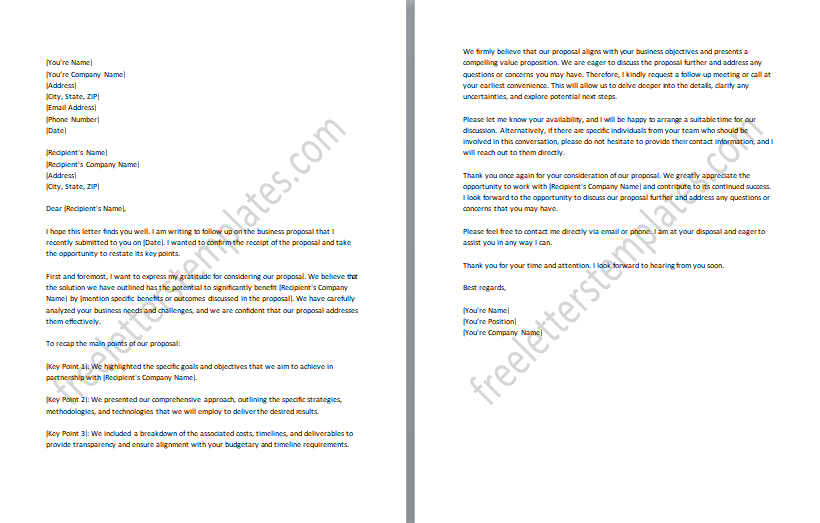
#8: Project Status Update Follow-Up Letter:
Inform stakeholders about the progress of a project, highlight achievements, and address any concerns or challenges. A Project Status Update Follow-Up Letter serves as a formal communication to stakeholders to provide them with an overview of the progress of a project. This letter allows you to share updates, milestones, and achievements that have been accomplished since the last communication. It provides an opportunity to address any concerns or challenges that have arisen and outline the steps being taken to mitigate them. The purpose of this letter is to keep stakeholders informed, maintain transparency, and ensure alignment between the project team and the stakeholders. By providing a comprehensive overview of the project’s status, this letter helps to foster trust, manage expectations, and enable stakeholders to make informed decisions.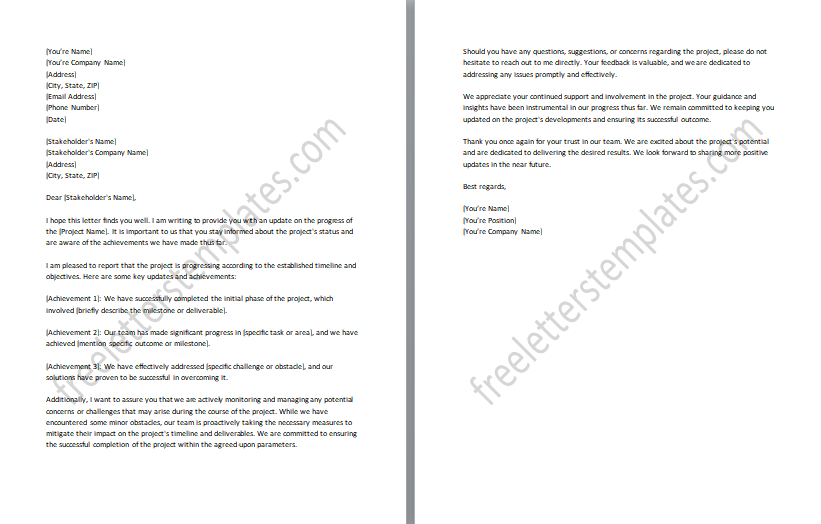
#9: Request for Information Follow-Up Letter:
Politely remind the recipient about your initial request, specify the information needed, and provide a deadline for response. A Request for Information Follow-Up Letter is a courteous means of reminding the recipient about your initial request for specific information. This letter allows you to politely restate the details of your original inquiry and specify the information that is still needed. It is important to provide a clear and reasonable deadline for the recipient to respond. By providing a deadline, you create a sense of urgency and facilitate a timely response from the recipient.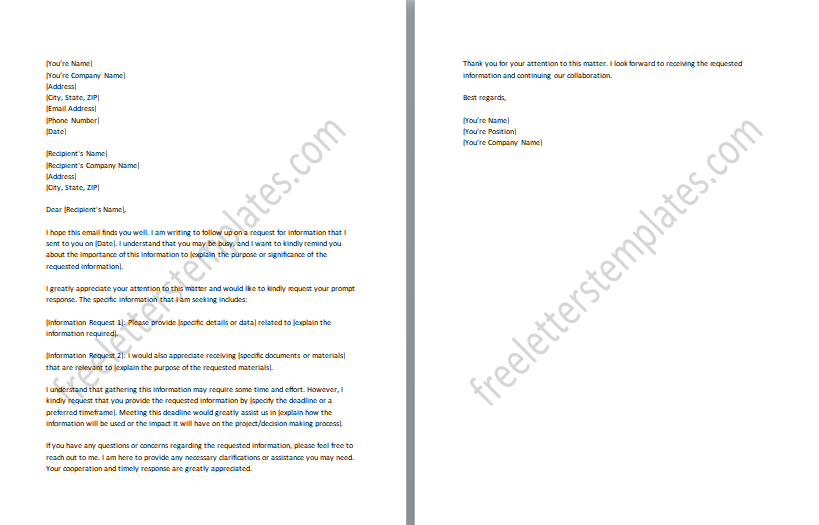
#10: Request for Quote Follow-Up Letter:
Follow up on a quotation request, express the urgency or importance of receiving the quote, and provide any additional details if necessary. A Request for Quote Follow-Up Letter serves as a friendly reminder to the recipient about your initial quotation request. This letter allows you to express the urgency or importance of receiving the quote, emphasizing the need for a prompt response. You can also provide any additional details or specifications if necessary, ensuring that the quote accurately reflects your requirements. The purpose of this letter is to maintain communication with the recipient, encourage them to prioritize and expedite the quotation process and ensure that you receive the necessary information to make informed decisions. By emphasizing the importance and timeliness of the quote, this letter aims to facilitate efficient and effective business transactions.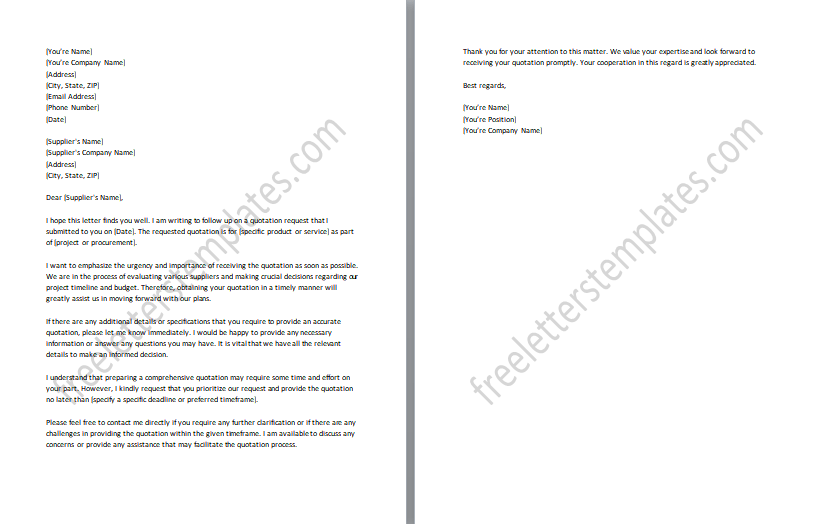
#11: Request for Payment Follow-Up Letter:
Send a gentle reminder about an outstanding payment, include invoice details, and specify consequences or late fees if applicable. A Request for Payment Follow-Up Letter is a courteous way to remind the recipient about an outstanding payment. This letter serves as a gentle reminder and includes important details such as the invoice number, the amount due, and the original due date. If applicable, you can also mention any consequences or late fees that may be incurred if the payment is not made promptly. The purpose of this letter is to maintain a professional relationship while ensuring that the recipient is aware of the outstanding balance and the importance of timely payment. By providing clear and concise information, this letter aims to encourage prompt payment and minimize any potential delays or issues related to unpaid invoices.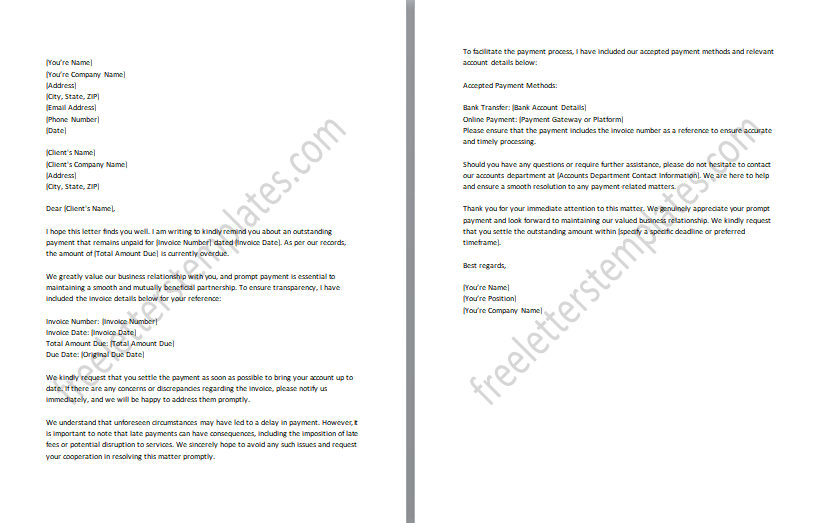
#12: Request for Recommendation Follow-Up Letter:
Politely remind the individual about your request for a recommendation, provide any additional information needed, and express gratitude in advance. A Request for Recommendation Follow-Up Letter is a courteous way to remind someone about your previous request for a recommendation. This letter allows you to politely reiterate your request, ensuring that it has not been overlooked or forgotten. You can also provide any additional information that might help craft the recommendation, such as specific achievements or experiences you would like them to highlight. Additionally, expressing gratitude in advance for their time and effort is important to acknowledge their willingness to support you. The purpose of this letter is to maintain open communication, show appreciation for their support, and ensure that the recommendation process moves forward smoothly. By reminding them and providing any necessary details, this letter helps strengthen your request and increases the chances of receiving a positive recommendation.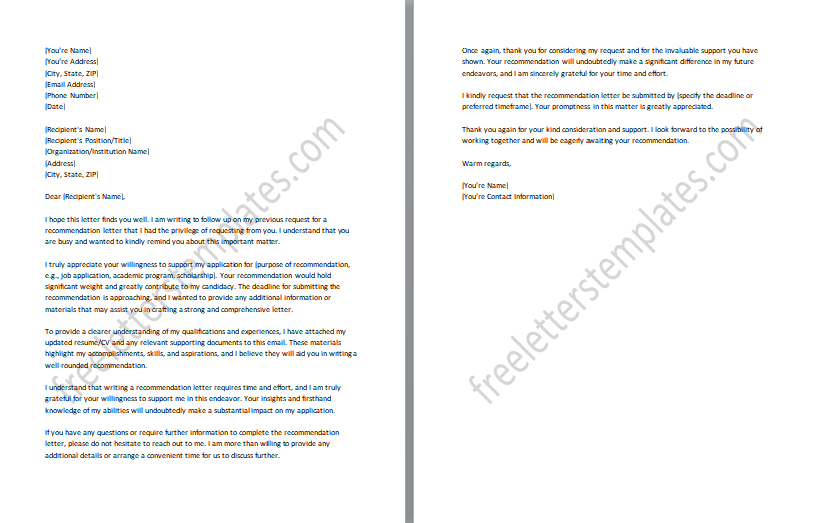
#13: Request for Collaboration Follow-Up Letter:
Express continued interest in collaboration, propose specific ideas or initiatives, and suggest a follow-up meeting or discussion. A Request for Collaboration Follow-Up Letter allows you to express your ongoing interest in collaborating with an individual or organization. This letter serves as a means to reiterate your enthusiasm for working together and further explore potential opportunities. You can propose specific ideas or initiatives that align with the shared interests and goals of both parties, showcasing your proactive approach to collaboration. Additionally, suggesting a follow-up meeting or discussion provides an opportunity to delve deeper into the details and logistics of the collaboration. The purpose of this letter is to foster ongoing communication, demonstrate your commitment to collaboration, and initiate the next steps in the process. By expressing your continued interest and proposing specific ideas, you aim to keep the conversation moving forward and solidify the foundation for a successful collaborative effort.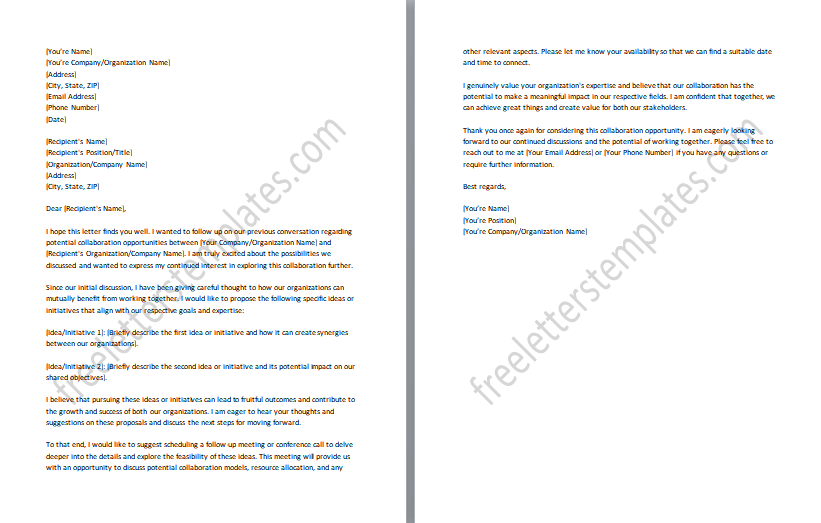
#14: Request for Sponsorship Follow-Up Letter:
Thank the potential sponsor for considering your request, providing additional information if requested, and expressing willingness to discuss further details. A Request for Sponsorship Follow-Up Letter is a way to express gratitude to a potential sponsor for considering your request. In this letter, you can thank them for their time and consideration, acknowledging the value they bring to your organization or event. If the potential sponsor has requested additional information, you can provide it in a concise and organized manner, addressing their specific inquiries. The purpose of this letter is to maintain a positive and professional relationship with the potential sponsor, demonstrate your appreciation, and show your commitment to exploring the sponsorship opportunity in more depth. By expressing your willingness to discuss this further, you open the door for continued communication and potential collaboration.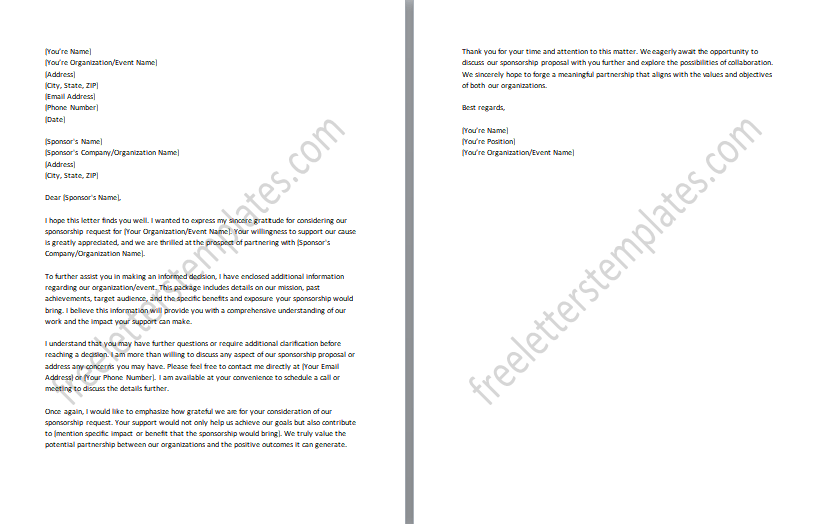
#15: Donation Request Follow-Up Letter:
Thank the recipient for their consideration, provide updates on the impact of their potential donation, and request a contribution or additional support. A Donation Request Follow-Up Letter is a way to express gratitude to the recipient for considering your donation request. In this letter, you can sincerely thank them for their thoughtful consideration and express appreciation for their support. It is also important to provide updates on the impact that their potential donation can make, highlighting any progress or success stories related to your cause or project. Additionally, you can kindly request their contribution or, if applicable, ask for any additional support they may be able to provide. The purpose of this letter is to maintain a positive connection with the recipient, update them on the importance and effectiveness of their potential donation, and invite them to take part in making a meaningful difference. By expressing gratitude, sharing impact updates, and kindly requesting their contribution, you aim to inspire their continued support and engagement.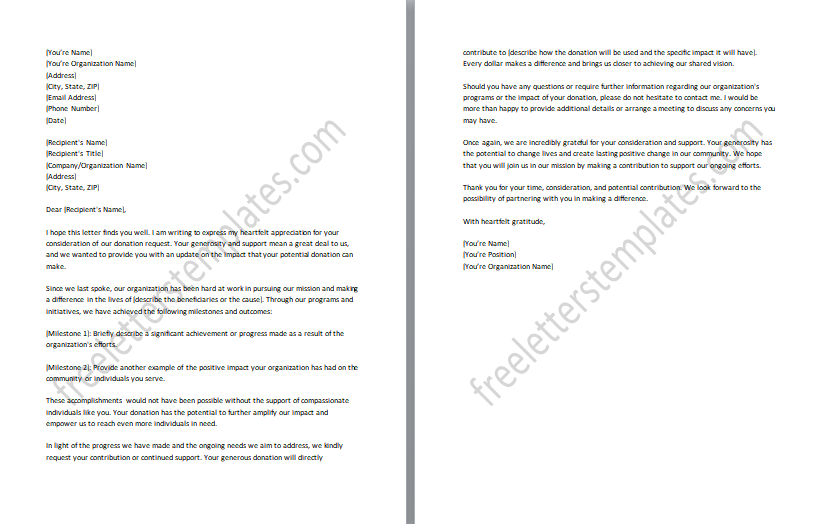
#16: Event RSVP Follow-Up Letter:
Confirm attendance or regrets for an event, express gratitude for the invitation, and provide any additional details requested. An Event RSVP Follow-Up Letter serves as a courteous way to confirm your attendance or regrets about an event. In this letter, you can express your gratitude for the invitation, acknowledging the thoughtfulness and consideration extended to you. It is also important to address any additional details or requests that were mentioned in the invitation, such as dietary preferences, special accommodations, or RSVP deadlines. The purpose of this letter is to maintain open communication with the event host, confirm your attendance or regrets, and ensure that all necessary information is provided for a seamless event experience. By expressing gratitude, acknowledging any additional details, and promptly responding to the invitation, you demonstrate your professionalism and respect for the event host’s planning efforts.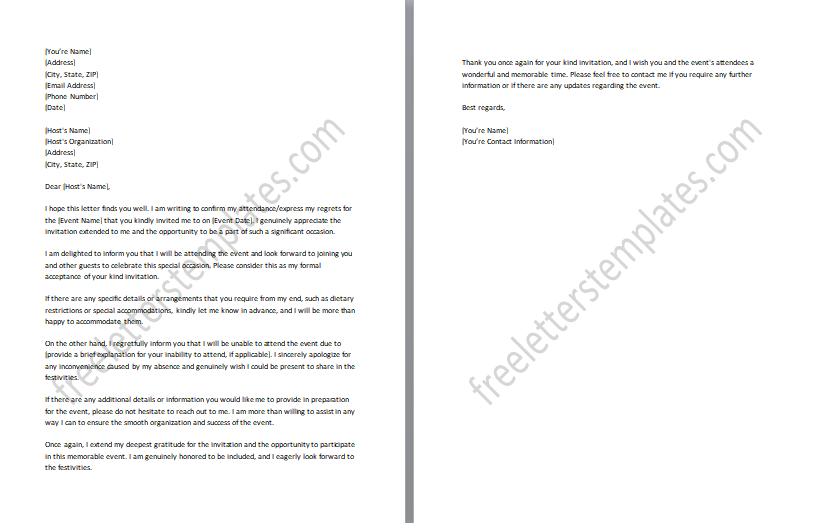
#17: Scholarship Application Follow-Up Letter:
Inquire about the status of your scholarship application, express enthusiasm for the opportunity, and provide any additional documentation if required. A Scholarship Application Follow-Up Letter allows you to inquire about the status of your scholarship application while expressing your enthusiasm for the opportunity. In this letter, you can politely request an update on the progress of your application, showing your continued interest in the scholarship. Additionally, you can mention your excitement about the potential to receive the scholarship and how it aligns with your academic and career goals. If any additional documentation or information is required, you can offer to provide it promptly to support your application. By inquiring about the status, expressing enthusiasm, and offering additional documentation if needed, you aim to enhance your chances of being considered for the scholarship.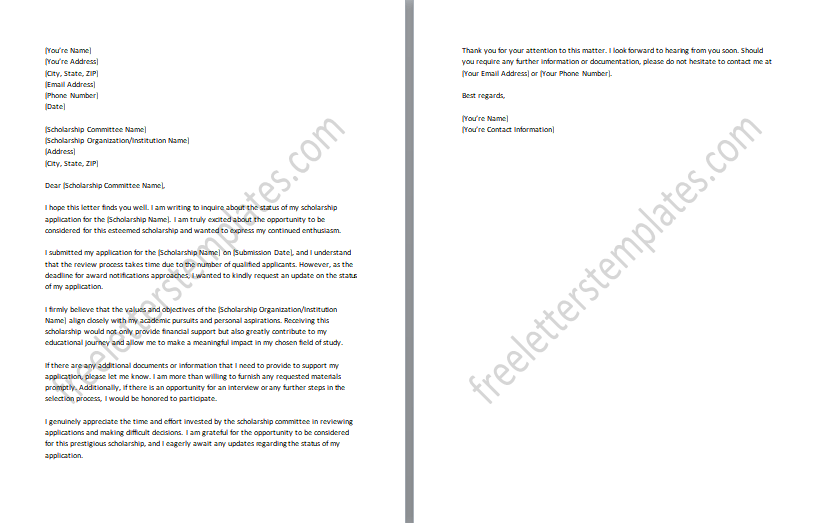
#18: Job Application Follow-Up Letter:
Follow up on the status of your job application, express continued interest, and inquire about the next steps or the timeline for a decision. A Job Application Follow-Up Letter allows you to follow up on the status of your job application while expressing your continued interest in the position. In this letter, you can politely inquire about the progress of your application, asking for an update on the hiring process or the timeline for a decision. It is important to reiterate your enthusiasm for the opportunity and highlight why you believe you are a strong fit for the position. By following up, expressing continued interest, and inquiring about the next steps or the timeline, you demonstrate your proactive approach and enhance your chances of receiving a response and progressing further in the job application process.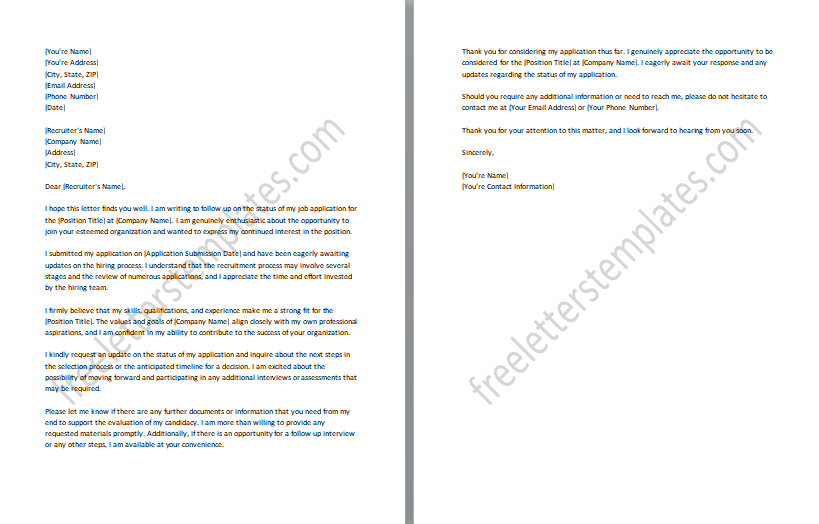
#19: Admission Application Follow-Up Letter:
Inquire about the status of your college or university admission application, express enthusiasm for the opportunity, and provide any additional information if requested. An Admission Application Follow-Up Letter allows you to inquire about the status of your college or university admission application while expressing your enthusiasm for the opportunity. In this letter, you can politely request an update on the progress of your application, showing your continued interest in the institution. Additionally, you can reiterate your excitement about the potential to be admitted and how attending the institution aligns with your academic and personal goals. By inquiring about the status, expressing enthusiasm, and offering additional information if needed, you aim to enhance your chances of being considered for admission.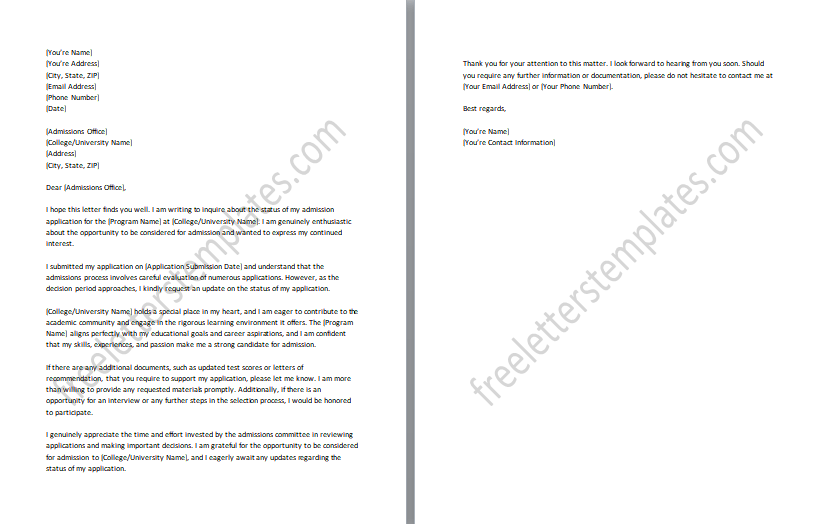
#20: School Enrollment Follow-Up Letter:
Confirm enrollment in a school or educational program, express appreciation for the acceptance, and request any further instructions or documentation needed. A School Enrollment Follow-Up Letter allows you to confirm your enrollment in a school or educational program while expressing your appreciation for the acceptance. In this letter, you can formally confirm your intention to enroll and express gratitude for the opportunity to be part of the educational institution. Additionally, you can kindly request any further instructions or documentation that may be required for the enrollment process, such as registration forms, tuition payment details, or orientation schedules. By confirming enrollment, expressing appreciation, and requesting any further instructions or documentation, you demonstrate your readiness and commitment to being a part of the school or educational program.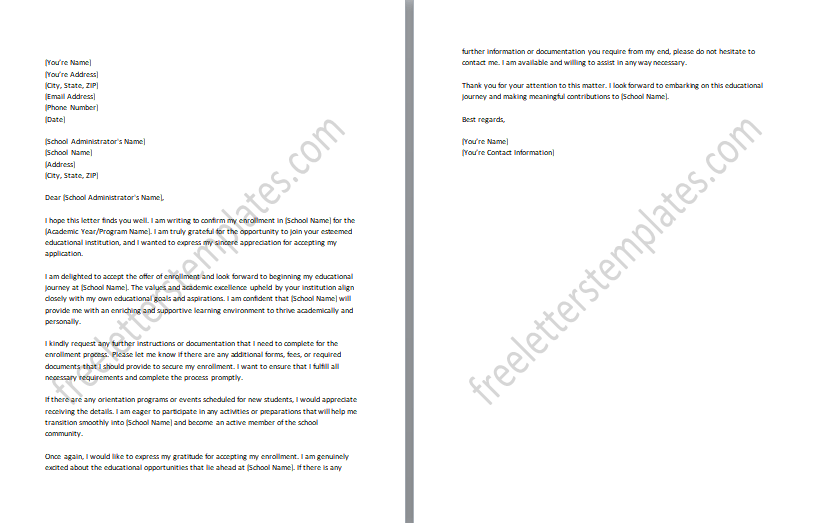
#21: Grant Application Follow-Up Letter:
Inquire about the status of your grant application, express gratitude for the opportunity, and offer any additional information or documentation required. A Grant Application Follow-Up Letter allows you to inquire about the status of your grant application while expressing gratitude for the opportunity. In this letter, you can politely request an update on the progress of your application, showing your continued interest in the grant. Additionally, you can express your appreciation for being considered for the grant and the potential impact it can have on your project or organization. If any additional information or documentation is required by the grant committee, you can offer to provide it promptly to support your application. By inquiring about the status, expressing gratitude, and offering additional information or documentation if needed, you aim to enhance your chances of receiving a response and being considered for the grant.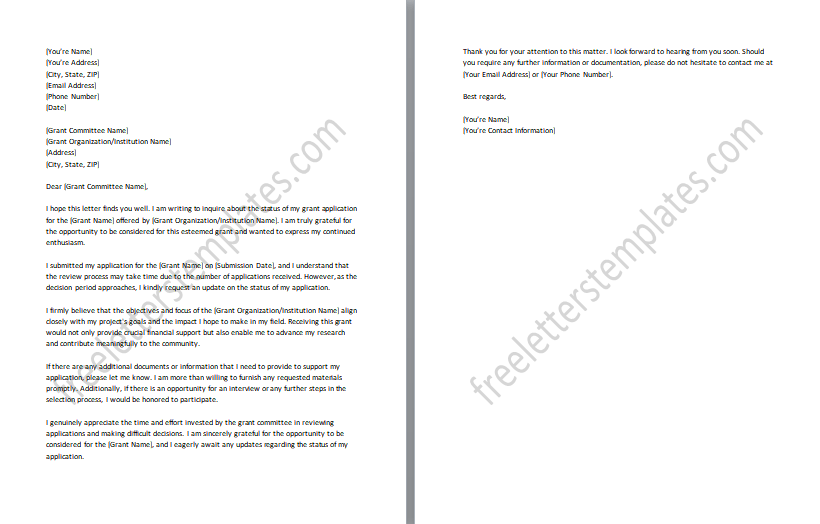
#22: Insurance Claim Follow-Up Letter:
Follow up on an insurance claim, provide any additional information or documentation requested, and inquire about the progress or decision. An Insurance Claim Follow-Up Letter allows you to follow up on the status of your insurance claim while providing any additional information or documentation requested. In this letter, you can politely inquire about the progress of your claim, expressing your interest in obtaining an update or decision. It is essential to mention that you have provided all the necessary information and documentation as per their request. By following up, providing requested information, and inquiring about the progress or decision, you aim to receive a timely response and a resolution to your insurance claim.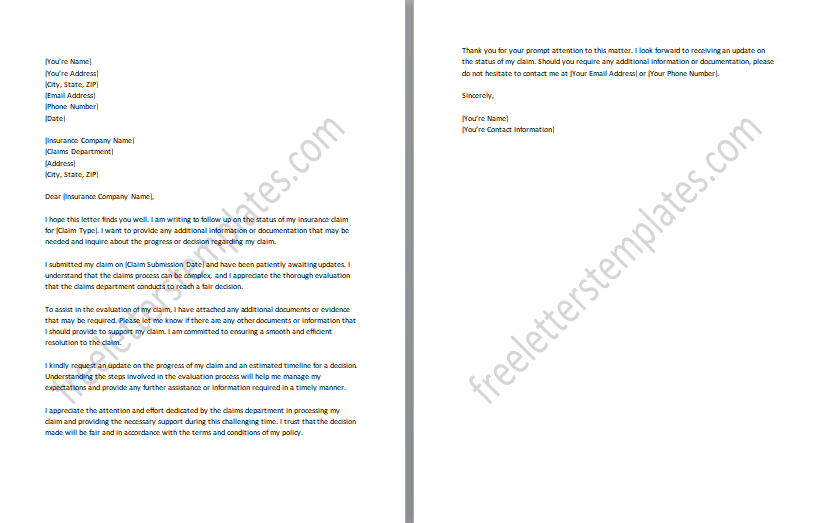
#23: Customer Service Follow-Up Letter:
Address a customer’s concern or issue, express empathy, provide a resolution or steps taken, and offer assistance for any further inquiries or problems. A Customer Service Follow-Up Letter allows you to address a customer’s concern or issue while demonstrating empathy and providing a resolution or steps taken to address the problem. In this letter, you can acknowledge the customer’s concern, express understanding of their frustration, and apologize for any inconvenience caused. It is crucial to provide a clear and satisfactory resolution to the issue, outlining the steps taken to rectify the situation or any actions that will be taken in the future. Additionally, you can offer further assistance or support for any additional inquiries or problems the customer may have. By addressing the concern, expressing empathy, providing a resolution, and offering assistance, you aim to ensure customer satisfaction and loyalty.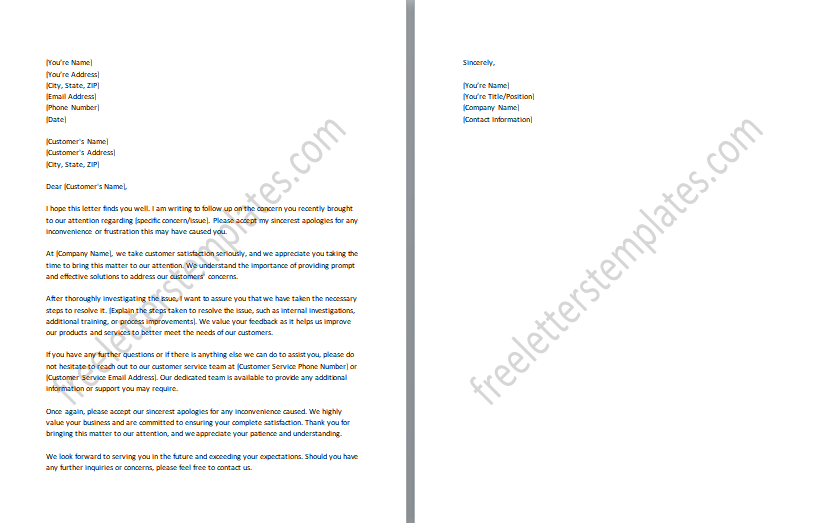
#24: Follow-Up on Complaint Letter:
Acknowledge a customer’s complaint, express regret for the experience, outline the actions taken to address the issue, and request feedback on the resolution. A Follow-Up on Complaint Letter allows you to acknowledge a customer’s complaint, express regret for the negative experience, outline the actions taken to address the issue and request feedback on the resolution. In this letter, you can begin by acknowledging the customer’s complaint and expressing genuine regret for the inconvenience or dissatisfaction they experienced. Additionally, you can request feedback from the customer to ensure their satisfaction with the resolution and to gather valuable insights for continuous improvement. The purpose of this letter is to demonstrate your commitment to customer satisfaction, show accountability for addressing the complaint, and maintain a positive relationship with the customer.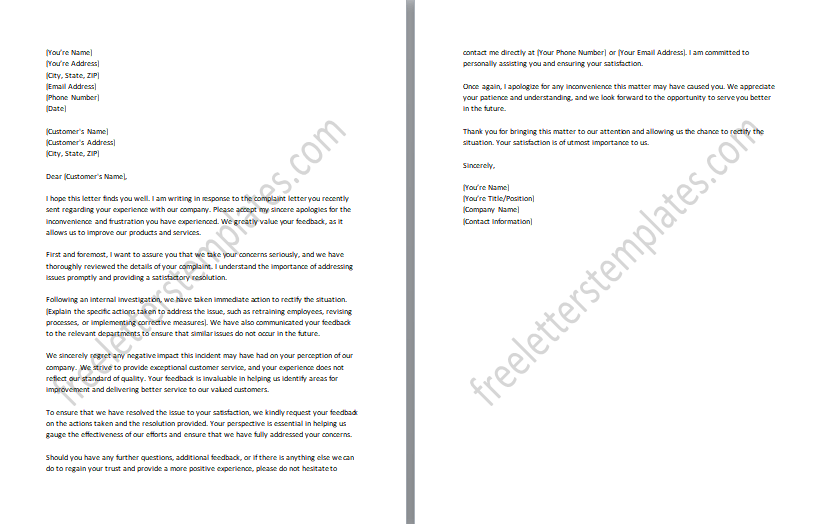
#25: Post-Event Follow-Up Letter:
Express gratitude to attendees for their participation in an event, summarize key highlights or takeaways, and provide any additional resources or follow-up actions discussed during the event. A Post-Event Follow-Up Letter allows you to express gratitude to attendees for their participation in an event, summarize key highlights or takeaways, and provide any additional resources or follow-up actions discussed during the event. It is important to recap the key highlights or takeaways from the event, emphasizing the valuable insights or experiences gained. Additionally, you can provide any promised resources or materials discussed during the event, such as presentation slides, handouts, or links to further information. Moreover, if there were any follow-up actions or next steps discussed, you can remind the attendees about them and provide any necessary instructions or deadlines.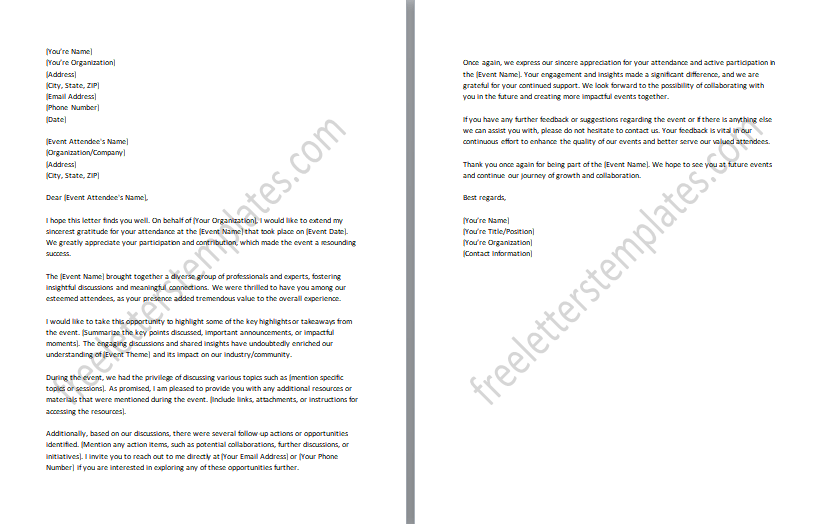
Etiquette for Follow-Up Communication
- Potential Employers:
- Be timely: Send a follow-up letter or email within 24-48 hours after a job interview to express your appreciation and reiterate your interest in the position.
- Use a professional tone: Keep the communication formal and respectful, addressing the recipient by their appropriate title.
- Personalize your message: Reference specific points discussed during the interview to show your attentiveness and engagement.
- Highlight relevant skills and qualifications: Briefly emphasize your relevant experience and how it aligns with the job requirements.
- Request next steps: Inquire about the hiring timeline or any additional information needed from your end.
- Clients:
- Express gratitude: Begin your follow-up communication by thanking the client for their business or considering your proposal.
- Provide updates: If applicable, share progress or updates regarding the project or service you are providing.
- Address concerns promptly: If the client has raised any concerns, address them in a timely and professional manner, offering solutions or alternatives.
- Offer assistance: Let the client know that you are available to address any further questions or provide additional support.
- Maintain regular communication: Depending on the nature of the relationship, establish a consistent follow-up schedule to ensure ongoing client satisfaction.
- Business Partners:
- Acknowledge their time: Express appreciation for any previous meetings or collaboration.
- Recap previous discussions: Briefly summarize key points or decisions made during previous interactions.
- Propose next steps or actions: Suggest specific ideas or initiatives for further collaboration or partnership.
- Arrange a follow-up meeting: Request a meeting or call to discuss in more detail and explore potential opportunities.
- Stay in touch: Keep the lines of communication open and maintain regular contact to nurture the business partnership.
Follow-Up Letter Mistakes to Avoid
- Being Too Pushy: Avoid coming across as overly aggressive or impatient in your follow-up letter. Maintain a polite and respectful tone while expressing your interest or requesting information.
- Using Generic Templates: Avoid using generic follow-up letter templates without personalization. Tailor your letter to the specific recipient and situation to demonstrate that you value their time and have put effort into crafting a thoughtful message.
- Failing to Proofread: Always proofread your follow-up letter before sending it. Spelling mistakes, grammatical errors, or formatting issues can make a negative impression and undermine the professionalism of your letter.
- Neglecting to Follow Up: Don’t forget to follow up if you haven’t received a response or if a promised action hasn’t been taken. Following up shows your proactive approach and commitment to the matter at hand.
- Being Too Lengthy: Keep your follow-up letter concise and to the point. Avoid unnecessary details or lengthy paragraphs that can overwhelm the recipient. Stick to the key points and maintain a clear and focused message.
- Overusing Jargon or Technical Terms: Ensure that your follow-up letter is easily understandable to the recipient. Avoid using excessive jargon or technical terms that might confuse or alienate the reader. Use language that is clear, concise, and accessible.
- Neglecting to Express Gratitude: Always express your gratitude and appreciation in your follow-up letter. Whether it’s for the opportunity, the recipient’s time, or their consideration, expressing gratitude demonstrates professionalism and leaves a positive impression.
- Lack of Follow-Up Action: Clearly state any follow-up actions or next steps you propose in your letter. Whether it’s scheduling a meeting, providing additional information, or requesting a specific response, make it clear what you expect or what you are willing to do next.
Conclusion:
In conclusion, follow-up letters play a crucial role in various aspects of professional and personal communication. Whether it’s expressing gratitude, requesting information, or seeking further collaboration, a well-crafted follow-up letter can leave a lasting impression and foster meaningful connections. By utilizing effective templates, following proper etiquette, and personalizing your messages, you can maximize the impact of your follow-up letters and increase the likelihood of achieving your desired outcomes. Remember to proofread your letters, maintain a professional tone, and always express gratitude for the recipient’s time and consideration.